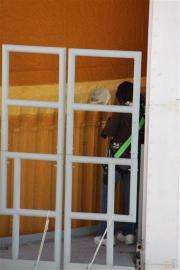Cracks found in shuttle fuel tank, not just foam (Update)

(AP) -- NASA discovered cracks in Discovery's fuel tank Wednesday, an added problem that will complicate trying to launch the space shuttle on its final voyage this year.
The two cracks - each 9 inches long - were found on the exterior of the aluminum tank, beneath a larger crack in the insulating foam that covers the 15-story tank. The cracks are in an area that holds instruments, not fuel.
NASA spokesman Allard Beutel said engineers believe the tank can be repaired at the launch pad, although it's never been tried before. It's unclear, though, whether the work can be done in time to meet a Nov. 30 launch attempt.
Discovery was grounded Friday by a hydrogen gas leak that cropped up during fueling Friday. It was the latest in a weeklong string of technical and weather postponements. A 20-inch crack in the foam was discovered soon after the last countdown was halted.
NASA managers said at the time they did not know if the foam crack itself would have postponed liftoff. But on Wednesday, officials said they will not attempt another launch until the foam and tank are patched.
The space agency has been cautious about fuel-tank foam ever since a slab broke off during Columbia's 2003 launch and pierced the left wing. The shuttle was destroyed during re-entry.
Discovery - NASA's oldest and most-traveled shuttle - must be flying by Dec. 6 or so, otherwise the flight to the International Space Station will be off until approximately February. That's because the Russians need to launch a new station crew in mid-December, creating a blackout period for a visiting shuttle. Then early next year, there is a series of unmanned supply ships, as well as a span of unacceptable solar angles.
The cracks in the ribbed section of the tank - the so-called central intertank region - were discovered as workers removed pieces of the damaged foam for analysis. This region joins the upper oxygen and lower hydrogen chambers that make up the rust-colored tank.
Since that section contains only instruments, no explosive fuel would have leaked, had the shuttle launched with the defects.
Beutel said it's possible NASA may have unknowingly launched shuttles in the past with these type of cracks in the tank. If it wasn't for the cracks traveling up to the surface of the foam this time, they would have gone unnoticed, he noted. The tank is discarded once a shuttle reaches orbit and breaks up while plunging back through the atmosphere.
Similar cracks have been fixed before at the tank production facility in New Orleans, Beutel said. But the work has never been attempted at Kennedy Space Center, least of all on the launch pad. He said engineers are looking at what it would take to fix the tank at the pad.
Repair work is continuing, meanwhile, on the unrelated hydrogen gas leak. The leak occurred on the tank, at the connection point for the vent arm. Workers are replacing seals and other parts at this location.
The flight by Discovery is currently the next-to-last for the shuttle program, winding down after nearly 30 years. One other mission remains on the official lineup, by Endeavour at the end of February. That final mission almost certainly would be delayed if Discovery is bumped into 2010.
More information: NASA: http://www.nasa.gov/mission-pages/shuttle/main/index.html
©2010 The Associated Press. All rights reserved. This material may not be published, broadcast, rewritten or redistributed.

















